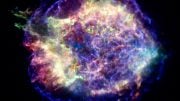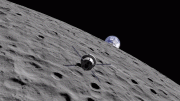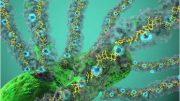
An image of an active, magnetically complicated region of the Sun captured by the new Hi-C instrument. It shows plasma in the outer solar atmosphere at a temperature of 1-2 million degrees Celsius. The inset box at bottom left shows ‘sparkle’ features that are releasing vast amounts of energy into the corona. The box at top right shows a close-up of part of a solar filament where ‘blobs’ of solar plasma flow along thread-like ‘highway’ structures. Credit: NASA MSFC and UCLan.
A team of scientists used a sounding rocket to launch NASA’s High Resolution Coronal Imager, capturing images of the solar corona five times sharper than anything seen before.
Using an innovative new camera on board a sounding rocket, an international team of scientists have captured the sharpest images yet of the Sun’s outer atmosphere. The team discovered fast-track ‘highways’ and intriguing ‘sparkles’ that may help answer a long-standing solar mystery. Prof. Robert Walsh of the University of Central Lancashire (UCLan) will present the new results on Monday 1 July at the RAS National Astronomy Meeting in St Andrews, Scotland.
With partners in the United States and Russia, the UCLan team used a sounding rocket to launch the NASA High Resolution Coronal Imager (Hi-C) from the White Sands Missile Range in New Mexico, USA. During its short flight, the Hi-C team obtained images of the solar atmosphere (the solar corona) five times sharper than anything seen before and acquired data at a rate of about one image every five seconds.
The ultra-high resolution images captured by NASA’s Hi-C instrument (High-resolution Coronal Imager) uncovered an amazing amount of detail within the hot outer atmosphere of the Sun (the Corona). The camera imaged electrified plasma at about 1 million degrees C and exposed phenomena scientists had never seen before.
The new camera observed the Sun in extreme ultraviolet light and focused on a large, magnetically-active sunspot region. Images from Hi-C reveal a number of new features in the corona, including ‘blobs’ of gas ricocheting along ‘highways’ and bright dots that switch on and off rapidly which the group call ‘sparkles’.
In the new images, small clumps of electrified gas (plasma) at a temperature of about one million degrees Celsius are seen racing along highways shaped by the Sun’s magnetic field. These blobs travel at around 80 km per second (the equivalent of 235 times the speed of sound on Earth), fast enough to travel the distance from Glasgow to London in 7 seconds. The highways are 450 km across, roughly the length of Ireland from north to south.
The flows of material are inside a so-called solar filament, a region of dense plasma that can erupt outwards from the Sun. These eruptions, known as coronal mass ejections (CMEs), carry billions of tonnes of plasma into space. If a CME travels in the right direction it can interact with the Earth, disturbing the terrestrial magnetic field in a ‘space weather’ event that can have a range of destructive consequences from damaging satellite electronics to overloading power grids on the ground. The discovery and nature of the solar highways allows scientists to better understand the driving force for these eruptions and help predict with greater accuracy when CMEs might take place.
Another new set of images could help explain an enduring mystery of the Sun. Astronomers have long struggled to understand why, with a temperature of two million degrees, the corona is around 400 times hotter than the solar surface. Hi-C images reveal dynamic bright dots which switch on and off at high speed.
These ‘sparkles’ typically last around 25 seconds, are about 680 km (420 mi) across (the size of the UK) and release at least 1024 (one million million million million) Joules of energy in each event or around 10,000 times the annual energy consumption of the population of the UK (based on information from the UK Department of Energy and Climate Change). The sparkles are thus a clear signal that enormous amounts of energy are being added into the corona and may then be released violently to heat the plasma.
Solar physicist Professor Robert Walsh, UCLan’s University Director of Research, added: “I’m incredibly proud of the work of my colleagues in developing Hi-C. The camera is effectively a microscope that lets us view small-scale events on the Sun in unprecedented detail. For the first time, we can unpick the detailed nature of the solar corona, helping us to predict when outbursts from this region might head towards the Earth.”
NASA Marshall heliophysicist Dr Jonathan Cirtain, principal investigator for the Hi-C mission said: “Our team developed an exceptional instrument capable of revolutionary image resolution of the solar atmosphere. We took advantage of the high level of solar activity to focus in on an active sunspot and obtained these remarkable pictures.”
Reference:
“Anti-parallel EUV flows observed along active region filament threads with HiC” by Caroline E. Alexander, Robert W. Walsh, Stéphane Régnier, Jonathan Cirtain, Amy R. Winebarger, Leon Golub, Ken Kobayashi, Simon Platt, Nick Mitchell, Kelly Korreck, Bart DePontieu, Craig DeForest, Mark Weber, Alan Title and Sergey Kuzin, 10 September 2013, The Astrophysical Journal Letters.
DOI: 10.1088/2041-8205/775/1/L32
arXiv:1306.5194









Be the first to comment on "Rocket-Launched Hi-C Camera Captures Detailed Images of the Solar Corona"